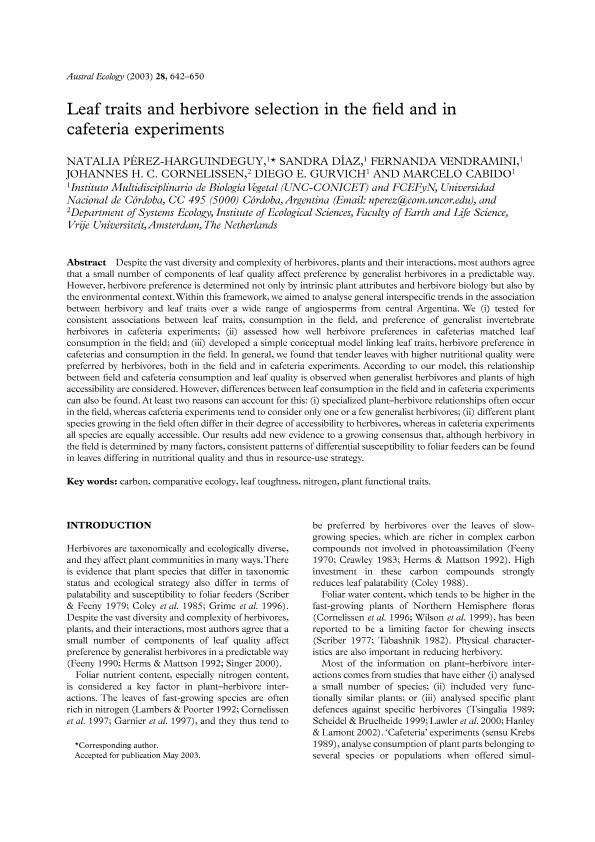Mostrar el registro sencillo del ítem
dc.contributor.author
Pérez Harguindeguy, Natalia

dc.contributor.author
Díaz, Sandra Myrna

dc.contributor.author
Vendramini, Fernanda
dc.contributor.author
Cornelissen, Johannes H. C.

dc.contributor.author
Gurvich, Diego Ezequiel

dc.contributor.author
Cabido, Marcelo Ruben

dc.date.available
2018-04-05T15:34:03Z
dc.date.issued
2003-12
dc.identifier.citation
Pérez Harguindeguy, Natalia; Díaz, Sandra Myrna; Vendramini, Fernanda; Cornelissen, Johannes H. C.; Gurvich, Diego Ezequiel; et al.; Leaf traits and herbivore selection in the field and in cafeteria experiments; Wiley Blackwell Publishing, Inc; Austral Ecology; 28; 6; 12-2003; 642-650
dc.identifier.issn
1442-9985
dc.identifier.uri
http://hdl.handle.net/11336/40864
dc.description.abstract
Despite the vast diversity and complexity of herbivores, plants and their interactions, most authors agree that a small number of components of leaf quality affect preference by generalist herbivores in a predictable way. However, herbivore preference is determined not only by intrinsic plant attributes and herbivore biology but also by the environmental context. Within this framework, we aimed to analyse general interspecific trends in the association between herbivory and leaf traits over a wide range of angiosperms from central Argentina. We (i) tested for consistent associations between leaf traits, consumption in the field, and preference of generalist invertebrate herbivores in cafeteria experiments; (ii) assessed how well herbivore preferences in cafeterias matched leaf consumption in the field; and (iii) developed a simple conceptual model linking leaf traits, herbivore preference in cafeterias and consumption in the field. In general, we found that tender leaves with higher nutritional quality were preferred by herbivores, both in the field and in cafeteria experiments. According to our model, this relationship between field and cafeteria consumption and leaf quality is observed when generalist herbivores and plants of high accessibility are considered. However, differences between leaf consumption in the field and in cafeteria experiments can also be found. At least two reasons can account for this: (i) specialized plant–herbivore relationships often occur in the field, whereas cafeteria experiments tend to consider only one or a few generalist herbivores; (ii) different plant species growing in the field often differ in their degree of accessibility to herbivores, whereas in cafeteria experiments all species are equally accessible. Our results add new evidence to a growing consensus that, although herbivory in the field is determined by many factors, consistent patterns of differential susceptibility to foliar feeders can be found in leaves differing in nutritional quality and thus in resource‐use strategy.
dc.format
application/pdf
dc.language.iso
eng
dc.publisher
Wiley Blackwell Publishing, Inc

dc.rights
info:eu-repo/semantics/openAccess
dc.rights.uri
https://creativecommons.org/licenses/by-nc-sa/2.5/ar/
dc.subject
Carbon
dc.subject
Comparative Ecology
dc.subject
Leaf Toughness
dc.subject
Nitrogen
dc.subject
Plant Functional Traits
dc.subject.classification
Otras Ciencias Biológicas

dc.subject.classification
Ciencias Biológicas

dc.subject.classification
CIENCIAS NATURALES Y EXACTAS

dc.title
Leaf traits and herbivore selection in the field and in cafeteria experiments
dc.type
info:eu-repo/semantics/article
dc.type
info:ar-repo/semantics/artículo
dc.type
info:eu-repo/semantics/publishedVersion
dc.date.updated
2018-04-03T19:20:08Z
dc.identifier.eissn
1442-9993
dc.journal.volume
28
dc.journal.number
6
dc.journal.pagination
642-650
dc.journal.pais
Reino Unido

dc.journal.ciudad
Londres
dc.description.fil
Fil: Pérez Harguindeguy, Natalia. Consejo Nacional de Investigaciones Científicas y Técnicas. Centro Científico Tecnológico Conicet - Córdoba. Instituto Multidisciplinario de Biología Vegetal. Universidad Nacional de Córdoba. Facultad de Ciencias Exactas Físicas y Naturales. Instituto Multidisciplinario de Biología Vegetal; Argentina
dc.description.fil
Fil: Díaz, Sandra Myrna. Consejo Nacional de Investigaciones Científicas y Técnicas. Centro Científico Tecnológico Conicet - Córdoba. Instituto Multidisciplinario de Biología Vegetal. Universidad Nacional de Córdoba. Facultad de Ciencias Exactas Físicas y Naturales. Instituto Multidisciplinario de Biología Vegetal; Argentina
dc.description.fil
Fil: Vendramini, Fernanda. Consejo Nacional de Investigaciones Científicas y Técnicas. Centro Científico Tecnológico Conicet - Córdoba. Instituto Multidisciplinario de Biología Vegetal. Universidad Nacional de Córdoba. Facultad de Ciencias Exactas Físicas y Naturales. Instituto Multidisciplinario de Biología Vegetal; Argentina
dc.description.fil
Fil: Cornelissen, Johannes H. C.. Vrije Universiteit; Países Bajos
dc.description.fil
Fil: Gurvich, Diego Ezequiel. Consejo Nacional de Investigaciones Científicas y Técnicas. Centro Científico Tecnológico Conicet - Córdoba. Instituto Multidisciplinario de Biología Vegetal. Universidad Nacional de Córdoba. Facultad de Ciencias Exactas Físicas y Naturales. Instituto Multidisciplinario de Biología Vegetal; Argentina
dc.description.fil
Fil: Cabido, Marcelo Ruben. Consejo Nacional de Investigaciones Científicas y Técnicas. Centro Científico Tecnológico Conicet - Córdoba. Instituto Multidisciplinario de Biología Vegetal. Universidad Nacional de Córdoba. Facultad de Ciencias Exactas Físicas y Naturales. Instituto Multidisciplinario de Biología Vegetal; Argentina
dc.journal.title
Austral Ecology

dc.relation.alternativeid
info:eu-repo/semantics/altIdentifier/url/https://onlinelibrary.wiley.com/doi/abs/10.1046/j.1442-9993.2003.01321.x
dc.relation.alternativeid
info:eu-repo/semantics/altIdentifier/doi/https://doi.org/10.1046/j.1442-9993.2003.01321.x
Archivos asociados
